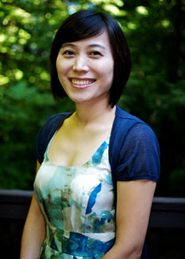Professor studies how teens view flash mobs and their violent potential
LAWRENCE — If you’ve seen a flash mob, chances are you’ve seen video of it online — a group of people spontaneously breaking into organized dance in a public place. But sometimes the gatherings, often organized via social media, can turn violent, as was the case in Kansas City in 2011 when shots were fired among a gathering of young people at the Country Club Plaza.
Hyunjin Seo, assistant professor of journalism at the University of Kansas, is a co-principal investigator of a research project to determine teenagers’ understanding of flash mobs, what may lead them to take part and what cities can do in response. The Kauffman Foundation and Greater Kansas City Community Foundation are funding the study. Leigh Anne Taylor Knight, executive director at the Kansas City Area Education Research Consortium, a research initiative under the Center for Science, Technology, and Policy at the Institute for Policy & Social Research at KU; and Brian Houston, assistant professor in the Department of Communication at the University of Missouri-Columbia, are the other co-principal investigators.
The researchers are collecting survey data through focus groups with a wide cross section of teens from the Kansas City area.
“We feel we don’t have enough previous insight that we can draw info from,” Seo said. “There have been news reports, but they vary widely. We want to know what is teens’ understanding of flash mobs? We didn’t want to define flash mobs for them.”
Teens were asked if they’ve ever participated in flash mobs and why, if their friends have and what exactly they think flash mobs are. Seo said the participants repeatedly cited boredom and a lack of opportunities for activity and recreation for teens as their reasons to take part. Though several of the research participants were at the Kansas City flash mob that ended in a shooting or knew someone who was, they felt they were unjustly labeled as violent. Flash mobs are viewed more as a chance to gather for fun or to dance harmlessly, not like the flash mob-inspired snowball fight that led to a police officer drawing his gun in Seattle in 2010.
“The majority of flash mobs have been nonviolent,” Seo said, “but sometimes they have taken a violent turn, and that’s what concerns cities.”
The researchers will make a report to the Kansas City Mayor’s Office, the Kauffman Foundation and Greater Kansas City Community Foundation when the results are final. Their hope is to deliver recommendations based on community input that the city can enact to guide response to such incidents in the future. Following the Country Club Plaza shooting, the city took measures to enforce a curfew for people under 18. Not surprisingly, the teen respondents did not have a positive view of the measure.
The project is examining the use of social media in organizing the events and exploring how factors such as self-efficacy, self-esteem, group identity and socioeconomic background affect teens’ likelihood to take part in the gatherings. Representatives from Kansas City’s Parks and Recreation Department have taken part in some of the focus groups, and Generation Rap, a youth-oriented radio station, helped recruit participants.
“Teenagers feel like people don’t care about what they think,” Seo said. “I think this was an important opportunity for city leaders to hear from them directly.”
While researchers are taking an academic approach to understand a cultural event in Kansas City, they feel the results shouldn’t be limited to professors and one city. Philadelphia, Boston and other major cities have had similar problems. Seo said they hope to publish the research and potentially share their findings with those cities and others to help increase the understanding of the relatively new phenomenon and how communities can react.
“I think there is an opportunity to collaborate with many other cities on this research. We see a lot of potential for future engagement with community centers and organizations,” Seo said. “This is not just academic research. We want communities to be involved as well.”
